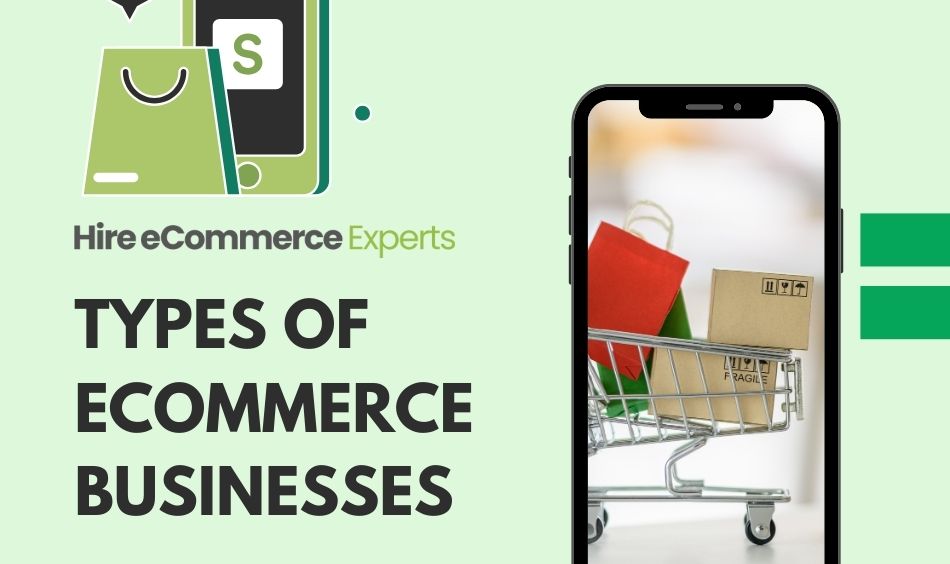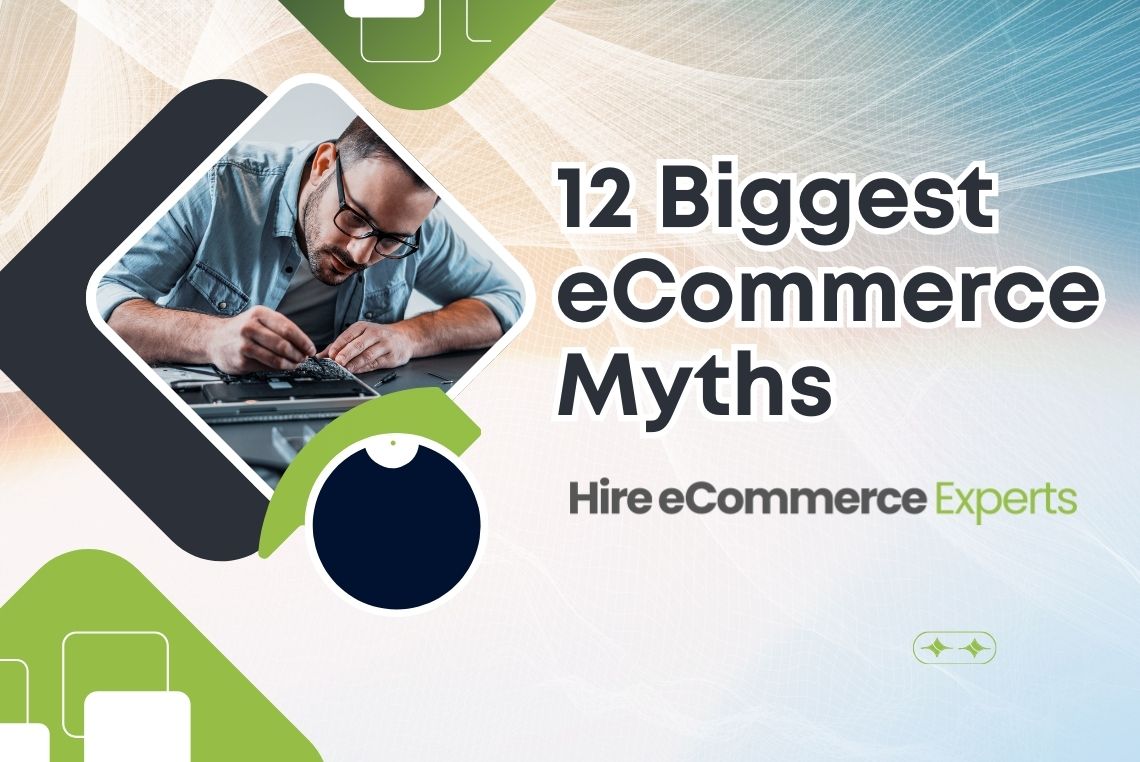Table of Contents
In the modern world, eCommerce has become a significant force in the business landscape. From major corporations to small startups, companies are increasingly moving their operations online. However, with the growth of this industry comes a myriad of misconceptions that can mislead and hinder progress. This blog will address twelve of the most prevalent myths about eCommerce and provide clarity on these issues. Before tackling these myths, it’s important to understand the basics of what eCommerce is, the different types of eCommerce businesses, and how to start your own online business.
What is an eCommerce Business?

eCommerce, or electronic commerce, refers to the buying and selling of products or services over the internet. It encompasses a variety of online business transactions and activities that take place through digital platforms. eCommerce has revolutionized the way people shop and conduct business, offering both convenience and global reach.
# The Evolution of eCommerce
eCommerce has come a long way since its early days. Initially, online shopping was a novelty, limited to a few early adopters and simple product listings. Today, eCommerce spans a broad spectrum, including sophisticated online stores, mobile apps, and integrated digital payment systems. This growth has been driven by technological advancements, shifts in consumer preferences, and the increasing demand for convenient shopping options.
# Key Components of eCommerce
- Online Storefront: This is the digital equivalent of a physical store where products or services are displayed for customers to browse and purchase.
- Shopping Cart: A software application that allows users to select and purchase items from an online store.
- Payment Gateway: A service that securely processes online payments, handling transactions between customers and businesses.
- Inventory Management: Tools and systems used to track stock levels, manage inventory, and handle order fulfillment.
- Customer Relationship Management (CRM): Systems designed to manage and analyze customer interactions and data to improve relationships and drive sales.
Types of eCommerce Businesses

eCommerce businesses come in various forms, each targeting different markets and offering distinct products or services. The main types include Business-to-Consumer (B2C), Business-to-Business (B2B), Consumer-to-Consumer (C2C), and Consumer-to-Business (C2B). Each model serves a specific purpose and requires unique strategies for success. To effectively set up and manage these diverse eCommerce models, investing in professional eCommerce development is crucial. This approach helps build a functional, user-friendly platform that meets the specific needs of your business model and enhances your ability to compete in the online marketplace. Here are the main types of eCommerce businesses:
1) Business-to-Consumer (B2C)
In the B2C model, businesses sell directly to individual consumers. This is the most common form of eCommerce and includes various online retail stores that cater to everyday consumers.
Examples:
- Amazon
- Walmart Online
- Netflix
2) Business-to-Business (B2B)
B2B eCommerce involves transactions between businesses. This model typically includes wholesale suppliers, manufacturers, and service providers who sell to other businesses rather than to individual consumers.
Examples:
- Alibaba
- ThomasNet
- Grainger
3) Consumer-to-Consumer (C2C)
C2C eCommerce facilitates transactions between individual consumers. This model is often represented by online marketplaces where users can buy and sell goods or services to each other.
Examples:
- eBay
- Craigslist
- Etsy
4) Consumer-to-Business (C2B)
In the C2B model, individual consumers offer products or services to businesses. This can include freelance work, crowdsourcing projects, or selling user-generated content.
Examples:
- Upwork
- Shutterstock
- Fiverr
5) Subscription-Based
The subscription-based eCommerce model involves offering products or services on a recurring basis, such as monthly or annually. This model is popular for digital services, membership sites, and subscription boxes.
Examples:
- Spotify
- Blue Apron
- Dollar Shave Club
How Can We Start an eCommerce Business?
Starting an eCommerce business involves several crucial steps, from identifying a market niche to building an online store and marketing your products effectively. One key to success is to hire eCommerce experts who can provide valuable insights and technical skills, ensuring your store is well-designed, user-friendly, and optimized for performance. These professionals can help streamline the setup process, manage technical aspects, and implement strategies that drive growth, allowing you to focus on running your business. Here’s a step-by-step guide to help you get started:
1) Identify Your Niche
Before launching your eCommerce business, it’s important to identify a niche that suits your interests and meets market demand. Conduct thorough research to understand what products or services are in demand and find gaps in the market that you can fill.
Tips:
- Analyze industry trends and customer preferences.
- Evaluate your own skills and interests.
- Validate your ideas through market research and competitor analysis.
2) Develop a Business Plan
A detailed business plan serves as a roadmap for your eCommerce venture. It should outline your business objectives, target audience, competitive landscape, marketing strategies, and financial forecasts.
Key Sections:
- Executive Summary
- Market Analysis
- Sales and Marketing Strategy
- Operations Plan
- Financial Projections
3) Choose Your Business Model
Select an eCommerce business model that aligns with your goals and resources. Whether you choose B2C, B2B, C2C, or another model, make sure it fits with your research and business plan.
Considerations:
- Type of products or services you plan to offer.
- Sales channels and platforms you will use.
- Potential revenue streams and pricing strategies.
4) Build Your Online Store
Creating an appealing and functional online store is essential for attracting and retaining customers. You can either build your store using platforms like Shopify, WooCommerce, or Magento or work with a developer to create a custom solution.
Components:
- Website Design and User Experience
- Shopping Cart Integration
- Payment Gateway Setup
- Mobile Compatibility
5) Implement a Marketing Strategy
To drive traffic and sales, you’ll need a strong marketing strategy. This includes a mix of digital marketing tactics such as search engine optimization (SEO), social media marketing, email campaigns, and paid advertising.
Strategies:
- Optimize for search engines to attract organic traffic.
- Engage with customers on social media platforms.
- Develop targeted email marketing campaigns.
- Utilize paid advertising to reach a broader audience.
6) Manage Operations and Customer Service
Effective management of inventory, order fulfillment, and customer service is crucial for running a successful eCommerce business. Invest in tools and systems that help you manage these aspects efficiently and ensure a positive customer experience.
Tools and Practices:
- Inventory tracking and management software.
- Efficient order processing systems.
- Reliable customer support channels.
Also read : Top 10 Benefits of Hiring Dedicated e-Commerce Developer
12 Biggest eCommerce Myths
Understanding what is true and what is not in the world of eCommerce is essential for making informed decisions and avoiding costly mistakes. Here are twelve prevalent myths about eCommerce that can mislead entrepreneurs and hinder success.
1) eCommerce is Only for Big Companies
Many people believe that eCommerce is the domain of large corporations with substantial resources. While big companies often have the means to invest heavily in technology and marketing, eCommerce is accessible to businesses of all sizes. The advent of platforms like Shopify, WooCommerce, and Wix has lowered the barriers to entry for small businesses. These platforms provide affordable tools and templates that allow anyone to set up a professional online store without a significant investment. Moreover, small businesses can leverage niche markets and personalized customer service to compete effectively against larger rivals.
Additional Insights:
- Small businesses can achieve success by focusing on specific niches that larger companies may overlook.
- Crafting a unique brand story and offering tailored products or services can attract loyal customers.
- Many successful eCommerce startups began with minimal resources and grew through smart marketing and effective customer engagement.
2) You Need a Huge Budget to Start
Starting an eCommerce business does not necessarily require a massive budget. While a larger budget can provide more flexibility in areas like marketing and inventory, many entrepreneurs have successfully launched online stores with modest investments. Platforms like Shopify offer cost-effective plans, and many tools for email marketing, social media, and SEO come with free or low-cost options. Additionally, the rise of dropshipping allows you to sell products without holding inventory, reducing initial costs significantly.
Additional Insights:
- Utilizing free or low-cost marketing strategies such as content marketing, social media promotion, and influencer collaborations can help grow your business.
- Starting with a small product range or offering digital products can reduce upfront expenses.
- Leveraging existing skills and resources can further minimize costs during the initial stages of your business.
3) Building an Online Store is Simple and Quick
The perception that building an online store is a quick and easy task can lead to disappointment. While setting up a basic online store might be straightforward with the help of various website builders, creating a successful and effective eCommerce site involves more than just setting up a platform. You need to carefully design your site for user experience, integrate payment gateways, manage inventory, and ensure that your site is optimized for search engines. Each of these elements requires attention to detail and time.
Additional Insights:
- Investing time in designing an intuitive and appealing user interface can significantly impact customer satisfaction and conversion rates.
- Testing different elements of your site, such as navigation and checkout processes, can help identify and resolve potential issues before launch.
- Continual updates and improvements based on customer feedback and performance analytics are crucial for long-term success.
4) You Can Ignore Mobile Optimization
Neglecting mobile optimization is a critical error. With a significant portion of online shopping now occurring on mobile devices, your eCommerce site must be fully optimized for smartphones and tablets. A mobile-friendly site not only enhances user experience but also influences your search engine rankings. Google’s algorithms prioritize mobile-friendly websites, so ensuring your site performs well on all devices is crucial for maintaining visibility and attracting customers.
Additional Insights:
- Mobile optimization involves more than just resizing content; it includes ensuring fast load times, easy navigation, and responsive design.
- Testing your site across various devices and screen sizes can help identify and address issues that may affect mobile users.
- Implementing mobile-specific features, such as click-to-call buttons and location-based services, can further enhance the user experience.
5) SEO is a One-Time Task
Many businesses mistakenly believe that SEO is a one-time task that, once completed, will continue to drive traffic indefinitely. In reality, SEO is an ongoing process that requires continual adjustments and updates. Search engines frequently update their algorithms, and competitors are always vying for top positions in search results. Regularly updating your content, optimizing for new keywords, and monitoring your site’s performance are necessary to maintain and improve your rankings.
Additional Insights:
- Conducting regular SEO audits can help identify and address issues that may affect your site’s visibility.
- Staying informed about changes in search engine algorithms and adjusting your strategies accordingly is essential for maintaining your rankings.
- Building high-quality backlinks and creating valuable content can contribute to long-term SEO success.
6) Social Media is Not Essential for eCommerce
Some believe that social media is not crucial for eCommerce success, overlooking its potential to drive traffic, build brand awareness, and engage with customers. Social media platforms provide valuable opportunities for connecting with your audience, sharing content, and promoting your products. Effective use of social media can lead to increased visibility, higher engagement rates, and ultimately more sales.
Additional Insights:
- Developing a social media strategy that aligns with your brand and target audience can enhance your online presence.
- Utilizing paid advertising on social media platforms can help reach a larger audience and drive targeted traffic to your store.
- Engaging with your audience through comments, messages, and user-generated content can build strong customer relationships and foster brand loyalty.
7) You Don’t Need to Worry About Customer Service
Customer service is often undervalued, but it plays a vital role in eCommerce. Poor customer service can lead to negative reviews, high return rates, and lost sales. Providing excellent support involves promptly addressing customer inquiries, handling complaints professionally, and offering hassle-free returns and exchanges. Building a reputation for outstanding customer service can lead to repeat business and positive word-of-mouth referrals.
Additional Insights:
- Implementing live chat or chatbot features can provide immediate assistance to customers and improve their overall experience.
- Regularly gathering and analyzing customer feedback can help identify areas for improvement and enhance service quality.
- Training your customer service team to handle various issues effectively and empathetically can contribute to higher customer satisfaction.
8) Higher Prices Mean Higher Profits
The belief that higher prices automatically lead to higher profits ignores the complexities of pricing strategies. Setting prices too high can drive customers away, while setting them too low may not cover costs adequately. An effective pricing strategy considers factors such as production costs, market demand, competitor pricing, and perceived value. Striking the right balance is crucial for maintaining profitability and competitiveness.
Additional Insights:
- Conducting market research to understand your customers’ price sensitivity and preferences can inform your pricing decisions.
- Experimenting with different pricing strategies, such as bundling or offering discounts, can help find the optimal price point.
- Regularly reviewing and adjusting your pricing strategy based on market conditions and customer feedback can help maintain profitability.
9) Dropshipping is a Get-Rich-Quick Scheme
Dropshipping is often promoted as an easy way to make quick money with minimal effort, but it requires careful planning and execution. Success in dropshipping involves selecting reliable suppliers, managing customer expectations, and developing effective marketing strategies. It is not a guaranteed path to instant wealth, but rather a business model that can be profitable with the right approach and dedication.
Additional Insights:
- Researching and vetting suppliers to ensure product quality and reliable fulfillment is essential for a successful dropshipping business.
- Building a strong brand and creating a compelling marketing strategy can differentiate your dropshipping store from competitors.
- Managing customer expectations and providing excellent service can help mitigate the challenges associated with dropshipping.
10) You Don’t Need to Worry About Website Security
Website security is a critical aspect of eCommerce that should not be overlooked. Ensuring that your site has secure payment processing, encryption, and regular security updates is essential for protecting both your business and your customers. Data breaches and cyberattacks can lead to significant financial and reputational damage, so investing in robust security measures is crucial.
Additional Insights:
- Implementing SSL certificates and secure payment gateways can help protect sensitive customer information during transactions.
- Regularly updating your website’s software and plugins can help address security vulnerabilities and prevent potential attacks.
- Educating your team about cybersecurity best practices and monitoring your site for suspicious activity can further enhance security.
11) Email Marketing is Dead
Despite the rise of new digital marketing channels, email marketing remains a powerful tool for eCommerce businesses. Email provides a direct way to communicate with customers, deliver personalized offers, and nurture relationships. An effective email marketing strategy can drive sales, increase engagement, and build customer loyalty.
Additional Insights:
- Segmenting your email list based on customer behavior and preferences can help deliver more relevant and personalized content.
- A/B testing different email campaigns and analyzing performance metrics can help refine your email marketing strategy.
- Incorporating automation tools for sending follow-up emails, abandoned cart reminders, and promotional offers can enhance the effectiveness of your email marketing efforts.
12) Once You Build It, They Will Come
The idea that simply launching an eCommerce store will lead to immediate success is a misconception. Building a successful online business requires ongoing efforts in marketing, customer acquisition, and site optimization. Attracting visitors to your store involves implementing effective marketing strategies, continuously improving your site, and engaging with your audience.
Additional Insights:
- Developing a comprehensive marketing plan that includes SEO, social media, and content marketing can drive traffic to your store.
- Regularly analyzing site performance and customer behavior can help identify areas for improvement and refine your strategies.
- Building partnerships, collaborations, and leveraging influencer marketing can further boost your store’s visibility and attract potential customers.
Also read : Top eCommerce Design Strategies to Maximize Your Online Store
Conclusion
As the world of eCommerce continues to evolve, distinguishing fact from fiction is crucial for building a successful online business. The myths outlined in this blog demonstrate that misconceptions can often mislead entrepreneurs and create unnecessary obstacles. Understanding the true nature of eCommerce—whether it’s the accessibility for small businesses, the ongoing nature of SEO, or the critical role of customer service—can help you make better decisions and develop strategies that truly work.
By addressing these myths, you can approach your eCommerce venture with a clearer perspective, better prepared to handle challenges and seize opportunities. Remember, success in eCommerce relies on continuous effort, adaptability, and a willingness to learn and grow.
If you’re looking to build or improve your online store, Shiv Technolabs is here to help. We specialize in creating high-quality, customized eCommerce solutions tailored to your business needs. Our expert team excels in Shopify Development that drive sales and engage customers effectively. Whether you’re starting from scratch or seeking to optimize an existing site, we provide the expertise and support needed to achieve your eCommerce goals. Contact Us today to transform your online presence and experience exceptional results.




















